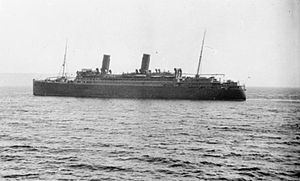Name Calgarian Beam 70.3 ft (21.4 m) Length 173 m | Fate Sunk 1 March 1918 Launched April 1913 Tonnage 15.88 million kg | |
 | ||
Draft 28 feet 6 inches (8.7 m) Depth 54 feet (16.5 m) molded to the bridge deck Propulsion 21,000 shp (16,000 kW) turbine engines Builder Fairfield Shipbuilding and Engineering Company | ||
HMS Calgarian was an armed merchant cruiser of the Royal Navy. She was sunk by the U-boat U-19 off Rathlin Island, Northern Ireland on 1 March 1918. The initial strike did not sink her, and the crew managed to contain the damage. The U-boat torpedoed her again, despite the protection of other ships. She was hit by 4 torpedoes and quickly sank with the loss of two officers and 47 ratings.
Contents
Construction
SS Calgarian was built for the Allan Line's primary service between Liverpool, England and the Canadian ports of Quebec and Montreal. The passenger and mail steamer was built by Fairfield Shipbuilding and Engineering Company Ltd., Glasgow with propulsion consisting of four Parsons-type steam turbines. External appearance was similar to an earlier ship built for the line, Alsatian constructed by another builder, but the ships differed in engineering design details.
Calgarian was 590 feet (179.8 m) length on waterline, 570 feet (173.7 m) length between perpendiculars, 70 feet (21.3 m) molded beam, with a depth molded to the bridge deck of 54 feet (16.5 m) and a mean designed draft of 28 feet 6 inches (8.7 m) and gross tonnage of 18,000 tons. There were eleven watertight bulkheads and a double bottom to the turn of the bilge.
Passenger capacity was 200 first class, 500 second class and 1,000 third class with a crew of 500 officers and men. Calgarian had eight decks: A being the boat deck, B the promenade, C the bridge, D the shelter deck, E upper deck, F main deck, G the lower and H the orlop with passenger accommodations on A through F decks. A somewhat novel feature was provision of a "scouting" motor launch capable of 7 knots with wireless and 400 yards (365.8 m) of steel wire tethering it to the ship for use in fog.
The outer port shaft was driven by a high-pressure turbine that exhausted into a medium pressure turbine driving the outer starboard shaft. The two middle shafts, capable of reversal, were each driven by a low-pressure turbine, which in emergencies could each be driven by exhaust from the high-pressure turbine. Each shaft drove a four-bladed bronze propeller for a designed sea speed of 19 knots. Steam was provided by six double-ended and four single-ended forced draft boilers divided between two boiler rooms. On trials in the Clyde Calgarian attained 21.25 knots and on a double run for contract speed made 20.63 knots, a knot and a half above required service speed.
Electrical power was provided by three 250 kW steam-driven generating sets with an 18 kW emergency generator located on the shelter deck above the waterline.
Commercial service
Calgarian made her maiden voyage from Liverpool to Canada on 8 May 1914.
Armed merchant cruiser
On 15 September 1914 Calgarian was taken over as an armed merchant cruiser. Her naval career saw her take part in the blockades of the ports of Lisbon and New York and acts as a troop and passenger transport across the Atlantic. Calgarian was at Halifax when the Halifax Explosion took place on December 6, 1917. Her crew assisted with rescue and medical relief.
She was officially transferred to Canadian Pacific in July 1917 on its acquisition of Allan. However, she continued in Royal Navy use until her sinking.
